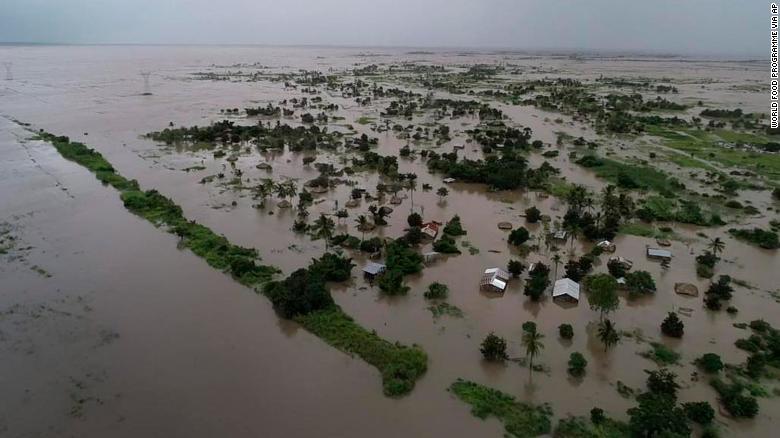Thousands of Cyclone Idai survivors cling to rooftops, aid agency says, as death toll rises

The Category 2 storm ripped through the southern African nation with 175 kph (109 mph) winds last week, flattening homes and buildings and causing widespread destruction as it moved through neighboring Zimbabwe and parts of Malawi. While the official death toll now stands at more than 200 in Mozambique, it is expected to rise significantly. On Monday, when the death toll was at 84, President Filipe Nyusi said that “everything indicates that we can have a record of more than 1,000 dead.” If casualties rise above that figure, Idai will be one of the deadliest tropical cyclones to hit the African continent.Rescue efforts hampered and more rain to comeEven though Idai dissipated after moving inland, alerts have been posted for this week by the National Meteorological Institute in Mozambique for heavy rain, thunderstorms and gusty winds, which could produce rainfall totals of 75 mm (3 inches) in 24 hours in the hard-hit province of Sofala, which includes the port city of Beira.The International Federation of Red Cross and Red Crescent Societies (IFRC) told CNN that it is planning for the possibility that another river could overflow, adding that rescue work was hampered the day before due to strong wind and rains. “The rescue efforts are ongoing, we’ve managed to secure more helicopters (and) we are serving people by boats and we are hoping this will allow us to bring in more people,” Caroline Haga, an IFRC communication specialist, told CNN. “Today we are hoping to rescue more than 1,000 people.””(The) areas of big concern are those still submerged,” added IFRC Africa’s head of communications, Euloge Ishimwe, which he said includes the rural area around Buzi River in central Mozambique, where “approximately 10,000 [survivors are] on rooftops, which requires an air operation.”‘Tragedy of biblical proportions’The High Commissioner for Mozambique in the UK, Filipe Chidumo, told CNN Wednesday that the country needs “a sustained effort on part of the Mozambican government as well as the international community” to help rescue stranded people, and provide, food, sanitation and water for the 350,000 people thought to be at risk. “This is a big tragedy of biblical proportions,” he said, adding that major work will be needed, including the restoration of electricity, water and sanitation to prevent the emergence of waterborne diseases, as well as repairs to public infrastructure. Inland sea of floodwaterMeanwhile, rescue workers in Beira have described scenes of devastation that will require a “significant emergency response… including medical services and water and sanitation support,” according to aid agency Médecins Sans Frontières (MSF). “The first thing you see when you arrive is destruction — and a lot of water,” Gert Verdonck, MSF’s emergency coordinator in Beira, said in a statement as the country began three days of national mourning over the unfolding disaster. Verdonck said the situation outside Beira, a city of around half a million people, “may be even worse,” adding that continued rain means it will be a while before floodwater recedes. “It’s difficult at this stage to have a clear picture of the medical needs. Actually, it’s even difficult to get to the health centers, because the roads are destroyed or because the health centers themselves are destroyed,” he said. Though the cyclone hit Mozambique on Thursday, the extent of the damage has taken days to come into focus due in part to the country’s poor infrastructure. Rescue efforts, which have been hampered by debris, heavy rains and destroyed infrastructure, have fanned out in central Mozambique in a bid to save people clinging to trees and rooftops amid an inland sea of floodwater, news agency AFP reports. A South African-led rescue operation by the South African Air Force and IPSS Medical Rescue managed to save 167 survivors in Beira. “Many of the team members are both physically and mentally exhausted and operational decisions on whether to fly members out and back to their families, will be made during the course of the day,” IPSS Medical Rescue said in a Facebook post. ‘90%’ of Beira has been destroyedThe situation in Beira was described by IFRC as terrible after an aerial assessment conducted by the agency Monday.A burst dam on Sunday cut off the last road to the low-lying city on the Indian Ocean, and IFRC spokesman Jamie LeSueur said up to 90% of the area had been destroyed. “The scale of devastation is enormous,” said LeSueur.Humanitarian groups have warned that flooding and wet conditions could lead to the outbreak of disease. “Waterborne disease is certainly a worry here,” MSF’s Verdonck said. “It is still raining right inside people’s houses, so pneumonia and other respiratory diseases are going to be a problem. And many people have gathered in schools or churches, where respiratory diseases can easily spread.”The charity Save the Children warned on Tuesday that aid workers are racing against time to save thousands of children trapped in Buzi, a district in the country’s central Sofala province, which could become submerged.An aerial survey by the charity showed that more than 50 kilometers of land in Buzi town have been inundated after a river burst its banks.”Thousands of children lived in areas completely engulfed by water. In many places, no roofs or treetops are even visible above the floods. In other areas, people are clinging to rooftops desperately waiting to be rescued,” said Machiel Pouw, Save the Children’s response leader in Mozambique.In neighboring Malawi, 56 people have died and nearly 600 are injured, according to MSF.Idai triggered floods in Zimbabwe that swept away hundreds of homes in the eastern and western parts of the country, authorities there said.The Ministry of Information said on Twitter Monday that 98 people had been confirmed dead. Hundreds more had been reported missing, while another 102 were injured and 42 marooned. Zimbabwe President Emmerson Mnangagwa has declared a disaster in the affected areas, the ministry said.Incoming aidThe European Union has said it will send $3.97 million (3.5 million euros) in emergency aid to Mozambique, Malawi and Zimbabwe. The United Arab Emirates has said it will send nearly $5 million (4.41 million euros) in aid to assist 600,000 people across the three countries.Britain will provide an extra $15 million (12 million pounds) of support, including food, water and shelter for the survivors of the cyclone, the secretary of state for international development said Wednesday. In total, the UK has pledged $23 million (18 million pounds) of aid to Mozambique, Malawi and Zimbabwe.Dubai’s International Humanitarian City said Tuesday that 400,000 people will benefit from a 97-metric-ton shipment of humanitarian aid. Dubai’s ruler Sheikh Mohammed bin Rashid Al-Maktoum has offered his private Boeing 747 to assist in delivering the aid.Amnesty International called on foreign governments and international aid agencies to “ramp up” resources and assistance for thousands of people who have been displaced, and those who are trapped in the aftermath of the disaster.The human rights organization also urged authorities in Mozambique and Zimbabwe, countries that are prone to flooding, to adopt climate change policies that could reduce the impact of these events.”As the effects of climate change intensify, these extreme weather conditions can be expected to revisit us more frequently. The devastation wrought by Cyclone Idai is yet another wake-up call for the world to put in place ambitious climate change mitigation measures,” said Muleya Mwananyanda, Amnesty’s deputy regional director for southern Africa.CNN’s Tara John wrote from London. CNN’s Meteorologist Brandon Miller, Nada Altaher and Anna Cardovillis contributed to this report.






